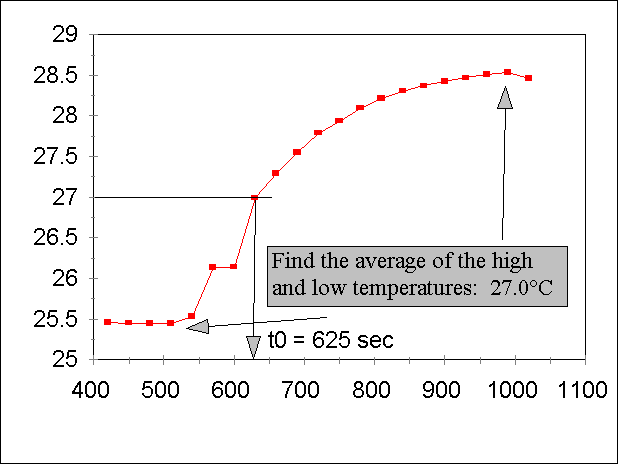Finding the Calorimeter Constant
The calorimeter constant is the net heat capacity of the bomb, the thermostat water,
the bucket, and the thermometer. It will vary from one apparatus to the next,
because the precise mass of each component will vary slightly. You need to know this
value in order to calculate how much heat is generated by combustion of your sample.
In general, the relation between what you measure (change in temperature of the thermostat
water) and the chemical change (the heat generated by combustion) is given by the simple
equation:
qobs = CDT
Here
- qobs is the energy released by combustion in calories;
- C is the calorimeter constant in calories per °C;
- DT is the temperature change induced by the heat absorption,
in °C.
(We could certainly use SI units of Joules instead of calories, though organic
thermochemistry has traditionally used the latter units.)
Measuring DT is somewhat involved. The calorimeter is
continually losing heat to the environment, and heat transfer from the inside of the bomb
to the water is not instantaneous. Therefore, we have to extrapolate the cooling
curve before ignition (the five minutes of data collection at first) and the cooling curve
after ignition to a "t0" point. This won't exactly be the
ignition time; it is the time at which the average temperature is passed. Take a
look at the following data set.

First, find the most linear portion of the two cooling curves. You will have to be
judicious in your choice! For example, if you do not use points late enough on the
upper cooling curve, Thigh will be too low and you will get inaccurate
results. Use a spreadsheet to perform linear regression for both cooling curves.
If r2 is not greater than 0.97, you need
to restrict the number of points used.
Next, you have to find the "t0"
point. Find the high and low temperature that you actually measure, and take
the average. Next, expand the X-axis for the T vs. time data, and find the time at
which the temperature passes this Tavg point. You will probably have to
interpolate your data; see below. Remember, you would like as many significant
figures as possible!

Use the slope and intercept of each cooling curve to find Tlow
and Thigh for X = t0. The difference between these two
temperatures is DT, the theoretical temperature that
would be seen if heat transfer were instantaneous. This is the value you use in the
equation above.
To calculate qobs, you must take into account heat generated
by combustion of methyl salicylate, heat generated by combustion of the iron wire, and the
error introduced by incomplete combustion (evidenced by formation of carbon soot).
For measurement of the calorimeter constant, the energy of
combustion of methyl salicylate is 5902 ± 1 cal/g. (No correction for PV work needs
to be done.) Multiply this by the mass of methyl salicylate you used to find DEsample.
The change in the mass of the iron wire is used to calculate DEiron.
Do not count the mass of any spherical nodules; these are iron oxide. Use you
spatula to knock these off the remaining wire. The energy of combustion for iron is
1.400 ± 0.001 cal/mg.
Soot represents energy that was not produced. By weighing the combustion capsule,
you can determine how much was formed. The energy that was not produced is 7.800
cal/mg soot.
After computing all three values, calculate qobs = DEsample + DEiron - DEsoot. Use this and DT
to determine C, the calorimeter constant.
The TA will tell you whether your result is in the acceptable range of ± 1% of the
accepted value. The purpose is to verify your technique and your ability to
correctly treat the data.
Q. The calorimeter constant is used in all
subsequent calculations. What impact would it have if your value is off by 1% from
the accepted value?
Back to calorimetry page
Back to CH362 Home Page
Comments to K. Gable

